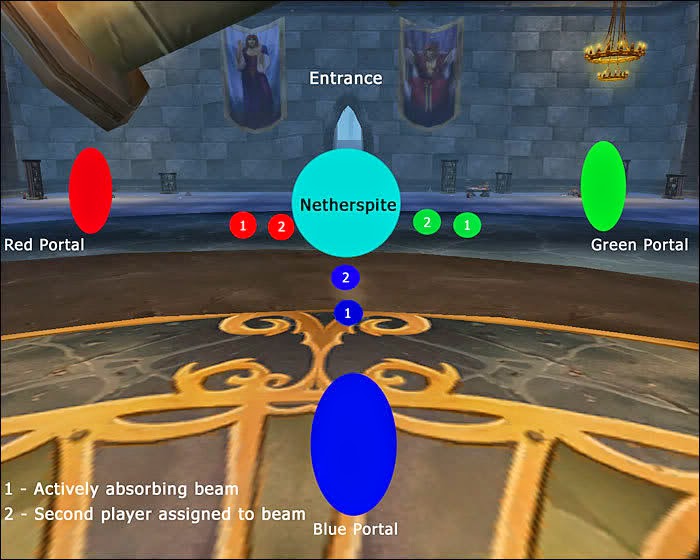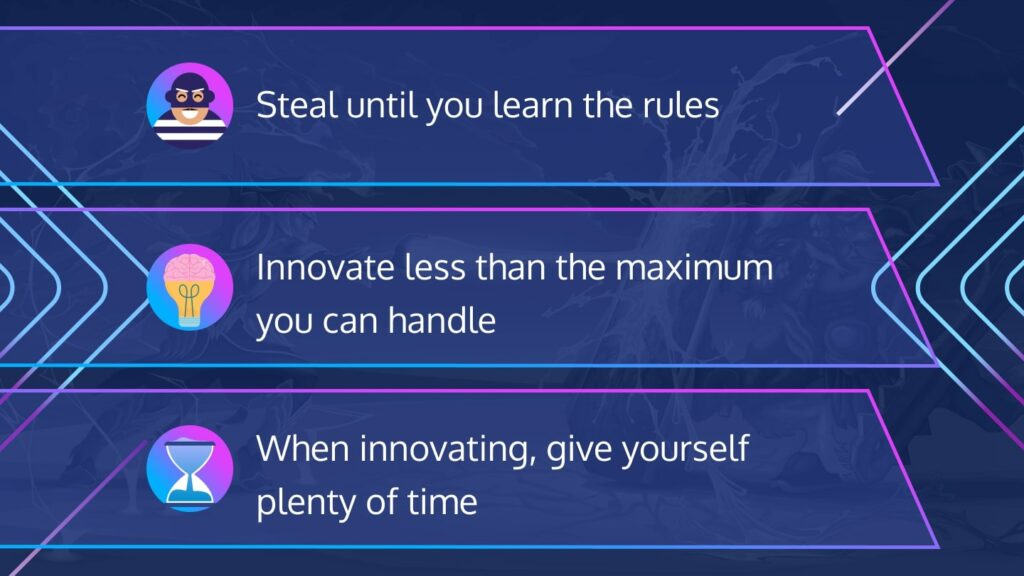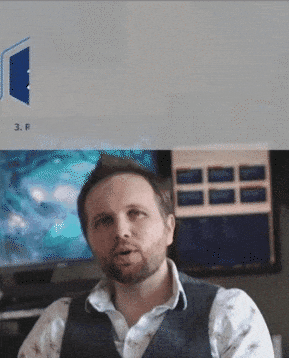“It is easier to make something complex than something simple.”
When it comes to game design, this surely can’t be true, right?
Let’s say you have an idea for a brand-new game. It’s got a thousand moving parts, new systems from the ground up, and a swarm of tiny rules to handle the edge cases. It could take years to perfect it—doesn’t that mean it’s difficult?
Yes and no.
Your project takes a lot of effort, but it also has a thousand knobs you can tweak as you go. If one component doesn’t work, you can cut it, or replace it with a totally different feature.
A simple thing does not have this luxury. It just works. If it’s well enough designed, the user will ignore its elegance. It works so smoothly that you don’t even notice the work that’s gone into it.
I will further expand on my points in the following parts:
- When to use existing tools vs. creating new ones.
- How to be a stronger designer by “stealing” other designers’ ideas.
- When to acknowledge your own limitations.
- How all of these lessons can help you come up with great game design ideas.
By the way, as you’re reading this post, if you have any questions or issues implementing you can get free help in the #game-design channel in Funsmith Club Discord, or you can DM me there.
Get notified each week on the latest game design tips, guides, templates, and workshops that I don’t share anywhere else here
Now, let’s dive into it.
Why You Should “Steal” Simple Ideas for Your Game

Just because a thing is simple, doesn’t mean it is crude or poorly thought out. Compare these two axes. Thousands of years apart, they both serve pretty much the same purpose.

They’re the same tool, the differences are astounding, everything has been improved:
- Material
- Size
- Weight
- Balance
- Shape
That’s only possible because each new generation of tool makers realized the axe was the right tool for the job.
That stone axe was a great starting point, and a long tradition of copycats built on that and improved the design.
If instead you invent the axe, but your student designs a saw, and the next person trains a bear to maul your lumber.
No one is learning from earlier work.
ESSENTIAL TIP: Recognize when the right tool already exists.
If you need to cut wood, try an axe. If your video game has platforms, let the player jump.
Copying Game Ideas to Teach Yourself Game Design
First-time game designers often get excited about big, original ideas. They want to make their own game, and maybe they’re afraid of being accused of plagiarism.
But if you look back at the craftsperson tradition, it’s filled with tales of young apprentices whose masters forced them into rote creation.
Generations of iteration have shown that you are a stronger creator if you’ve started out mimicking someone else first.

Also if you think about it, how can you innovate meaningfully when you don’t have the understanding and a certain amount of mastery of the fundamentals yet?
The other thing to keep in mind is that the majority of the innovations platform off of previous knowledge and ideas. So you have to mimic to learn before you can innovate.
I started out by stealing every idea I ever had:
- The first comic book I drew was mostly a retelling of Super Mario World.
- The first story I wrote was a thinly veiled fantasy version of the Cold War.
- And the first boss I created in World of Warcraft, Attumen, was stolen off the whiteboard of my manager (and game design mentor) Scott Mercer.
How this happened is important. Scott handed me the pre-planned design and told me to steal it and focus only on making it.
This is the great thing about theft—like the apprentice crafter, I could focus on the physical labor required to bring an idea to life.
“The practice of implementing existing ideas trains a game designer to understand and evaluate features.”
Sure, it’s “just” an axe (or “just” a standard boss fight)—but firsthand experience teaches you to appreciate all the simple, easily missed design elements that contribute so much.
But a designer also needs the ability to come up with new ideas. If you rely on mimicry forever, you are unable to adapt to the changing needs of your environment.
Many people, unfortunately, become hung up on one or the other aspect of design. Either:
- They steal everything they see and end up with a derivative game
- Or, they make everything brand new and lose all of the lessons others have learned.
Speaking of which…
Too Much Innovation Can Hurt Your Game—or Cause Development Hell

After working on Attumen, my next boss was a guy known as the Shade of Aran. Stretching my wings, I tried to stick to a lot of basic, easy stuff and only mixed in a little new stuff. The result turned out okay.
What is more important right now is what happened to me after I finished him.
I was riding so high on having successfully brought my own personal concept to life that I got overconfident.

The recognition I got for that boss told me:
- Everything you believed was right.
- You can innovate even further now.
- No limits.
WRONG.
I quickly lost sight of the basic things I had done right on Shade and decided to go into wacky land.
In fact, I straight-up OD’ed on innovation, and the result was… Netherspite.
Netherspite was a boss fight so far removed from the reality of the game that it constantly broke the game’s rules.
In fact, the encounter was so far detached from the rest of the game that a normal group required elaborate diagrams and planning to execute it properly.

Please don’t misunderstand: planning is an excellent part of a deep, fulfilling multiplayer gaming experience. However, this encounter required such high levels of execution, just to adapt to what were ultimately my whims, that many players chose to skip this encounter every week.
Furthermore, about half of the work I did in Karazhan involved fixing bugs, timing issues, and random AI quirks that occurred under the bizarre rules of Netherspite.
I made that picture of Netherspite my desktop background at work for about a year, to remind me of what happens when you let your personal lust for innovation take over.
Balancing Old and New Ideas
I was lucky. My team at Blizzard was incredibly forgiving and I was able to script my way out of the hole I created for myself on Netherspite.
But my innovation still came at a price.
After Netherspite, I was reassigned to work on the most basic content in the game.
Basically, I was told that until I mastered the basics, I needed to stay away from content that allowed me to get away with overly complex designs.
Innovation is a vital part of game design—but for it to work you need to be aware of your own limitations.
You have to be a student as well as a new inventor.
- Steal too much and you never develop the mental muscle required to handle the more complex problems.
- Innovate too much and you’ll consume all of your resources fixing bugs.
Just go into your game design work knowing that both approaches are important, and check in with yourself and your team as you go to see if you’re falling too far in one direction or another.

Be aware of the time cost of innovation as well.
In my experience, it generally takes 4 to 8 times longer to create a new thing than it does to improve an old thing.
Which means in the beginning by “stealing” (aka mimicking) you’ll learn 4 to 8 times quicker as well. This is especially powerful if you can combine this with a practical design decision methodology such as the 3C’s or Player Centric Framework.

See How You Can Learn the Gameplay Design Abilities Game Studios Are After To...
- Get more interview invites & job offers
- Replicate decisions that make games fun
- Learn faster with mentorship guidance
So, if you’re like me and constantly feel the call to innovate, plan ahead.
But I MUST Innovate, or I Mean Nothing

The above sentence is a crying voice that still haunts me every day. In fact, I regularly succumb to this fear. It’s totally normal to have this thought.
But there’s one thing to keep in mind, one thing that is incredibly hard to accept and incredibly powerful once you do:
There will always be another chance.
Maybe not on this boss, maybe not in this situation, maybe not even in this game, but another opportunity will come up again. As long as you don’t give up on yourself, you’ll continue to grow.
Lessons Learned
- Recognize when the right tool already exists.
- You are a stronger creator if you start out mimicking someone else first.
- Be aware of your own limitations.
- It generally takes 4 to 8 times longer to create a new thing than it does to improve an old thing.
Feel free to share your thoughts below!














7 Responses
This is something I`ve lived, but never really realized. I just see it as pulling from many different places, and putting it together with a touch of my own ideas.Also goes to show sometimes doing too much puts you in the hole rather than doing less. Need that balance.Overall, I can say I have great respect for you. Shade is probably my favorite encounter to this day, and most of Karazhan as well. I remember when it was difficult, and I learned much from the raid as a whole on game design.
For the record, Netherspite was my favorite fight in Kara, and I’m incredibly sad my group was one of those you talk about who usually skipped it. Of course, Shade of Aran was my most hated fight so you can’t win them all.
I entirely agree. The wretched chaos of tanking all the elementals, running away to LOS arcane explosion, running close and standing for flamewreath was an insane and painful mandala of hurt emblazoned on my soul to this day. The comparatively simple mechanic of Netherspite; rotate the beams, is something my raid could easily pull off.
You must have been playing a rogue or warrior. 🙂
The first time I’ve seen and downed Nethrspite was on WotLK. I had some experience in the game and my cousin was leveling her first toon and had just hit 70. We decided to gather some guildmates and show her what a raid is. We chose Karazhan.Most of us were 80-s, so we were simply nuking the bosses. We tried this method with a big, ghost-like dragon we saw in a side room too.A few moments later we were lying on the floor, wondering “WTF was that?” and if the warlock had soulstoned someone who can resurrect.Someone suggested skipping it, but I disagreed and as a raid leader read the tactic on Wowhead. It took me a while to finally figure out what should we do to prevent the dragon from healing itself. At least i thought so.We tried one more time. It went better, as we had assigned some people to standing in the green portals to lock the beams, but in the end we were left with only two people alive and the rest screaming at them to finish Netherspite off. We managed, and there was one big “YEEEEEAAAH!!!” on TeamSpeak.This way Netherspite ended being my favourite TBC boss, as i did all the other 70-lvl raids later, and my cousin started to continuously ask me when do we go on a raid again.
This was a great post. I think I can share my experience then.I was in a course for geometrical algorithms, and me and another guy came from Skellefteå (which is a smaller town, that only have a few unique courses from the main Uni in Luleå). We knew we were better programmers than the Engineer Masters 5th years, even though we were 3rd year Bachelors. We have much more practice coding, and both of us kinda looked down on the guys being at the main branch of the university.At the same time the main branch have no clue what is going on, and looks down upon us.Last project of the course, you was given a geometrical problem and allowed to solve it. I picked making a countour from several rectangles. I got cocky, and instead of looking up how to solve it from the book or on the internet, I decided to re-invent the wheel.I made up my own solution for the problem. My solution was clumsy, didn’t work in all cases, but solved the problem. I had to use a power point presentation heavy with pictures to even have people understanding what the hell I was doing. I was really proud of my innovation, and I had not yet noticed how lacking it was.Coding it was true hell, it was NOT made for coding first hand, I’ve had to redo it 2-3 times already, and spent around 2-3 months on it. We got about 1 week – 1 month to finish it, depending on how fast we choose subject.In the end things got so horribly delayed because of my own innovated solution, and result is not very good on top of that.When Mr Brazie says keep down on the innovation, he is really speaking the truth, and it’s a really good advice.
Thanks, great post.